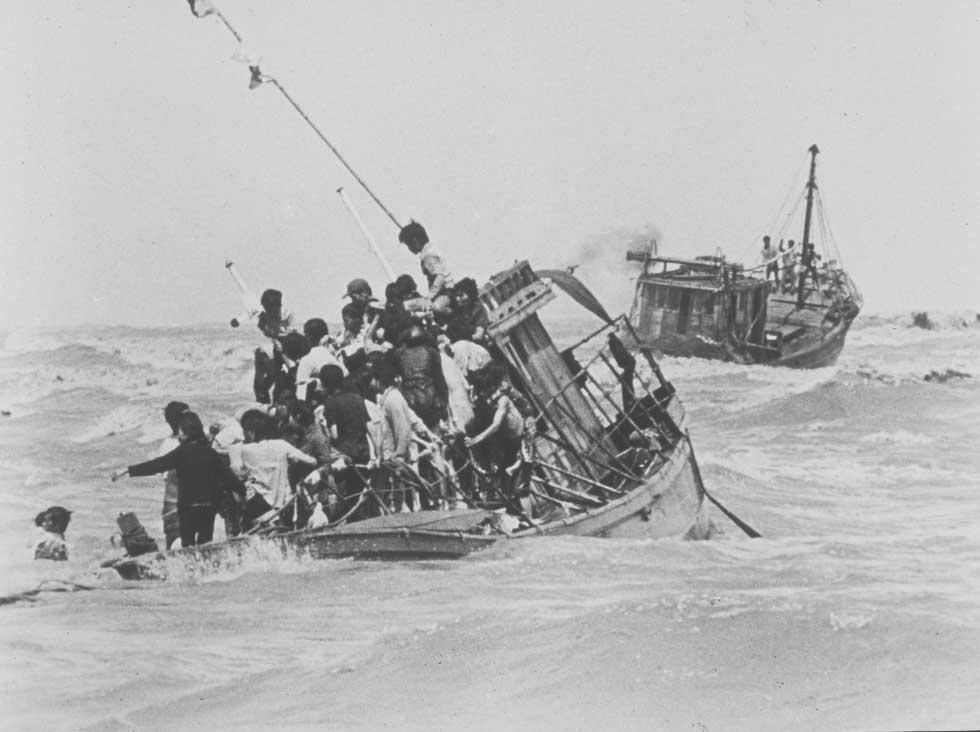


About this record
This black-and-white photograph shows a boat crowded with Vietnamese men, women and children in heavy seas; ahead of it and travelling in the same direction is another boat with a small number of people standing on the deck. The photograph is captioned on the reverse 'Disaster and rescue in the South China Sea, 1979'.
Educational value
- When the Vietnam War ended with the fall of South Vietnam to the National Liberation Front (also known as the Vietcong), 130,000 South Vietnamese fled the country fearing for their lives and futures under the incoming communist regime. These people became refugees—people who seek refuge or asylum in another country due to war, persecution or natural disaster.
- The photograph captures the perilous situation of Vietnamese refugees in a moment of danger, with an overcrowded boat close to sinking in the heavy seas and one person in the water. Tens of thousands of Vietnamese people took to the South China Sea in boats that were in many cases unseaworthy; thousands died from hunger, disease, piracy, murder and the ocean itself. It is thought that as many as 10 to 15 per cent of the Vietnamese who fled by boat died at sea.
- The photograph shows an element of the largest mass departure of asylum seekers by sea in modern history. Those who took part in the exodus at this time were called 'boat people' because they took to the water hoping to reach nearby countries, including Thailand, Indonesia, Hong Kong and Malaysia. In desperation, tens of thousands of Vietnamese people risked their lives to flee their country. With no prospect of returning to Vietnam, these people left their homes and most of their possessions and risked everything for an uncertain future.
- The Vietnamese boat shown in the photograph may have been turned back from Malaysia. In 1979 Malaysia announced that Vietnamese refugees arriving in the country would be shot. In June of that year, as the typhoon season neared, Malaysia towed 2500 Vietnamese back to sea and set them adrift. There are at least 500 documented cases of drowning that occurred as a direct result of this policy.
- The humanitarian crisis following the end of the Vietnam War hastened Australia's development of a refugee policy that was distinct from its immigration policy. In 1977 the Minister for Immigration and Ethnic Affairs, Michael MacKellar, announced that Australia was increasing the number of refugees it would accept into the country annually. Australia increased its intake of Vietnamese people during this period. In 1975 less than 1 per cent of Australia's new migrants were Vietnamese but, as a result of the refugee crisis, Vietnamese migrants made up over 17 per cent of the total intake of migrants in 1979. By 1982 Australia had admitted around 54,000 Vietnamese.
- The photograph shows part of the South China Sea, which borders Vietnam and is part of the Pacific Ocean. The South China Sea covers an area of approximately 2.2 million square kilometres lying between mainland Asia to the east and the Philippines and Borneo to the west, and stretching from Singapore in the south to the Strait of Taiwan in the north.
- The photograph shows the two vessels from the vantage point of another vessel. The caption mentions 'disaster and rescue', and while the image does not show a rescue taking place, the photograph was most likely taken by someone on an Australian boat involved in rescue.
Acknowledgments
Learning resource text © Education Services Australia Limited and the National Archives of Australia 2010.
Related themes
Need help with your research?
Learn how to interpret primary sources, use our collection and more.




